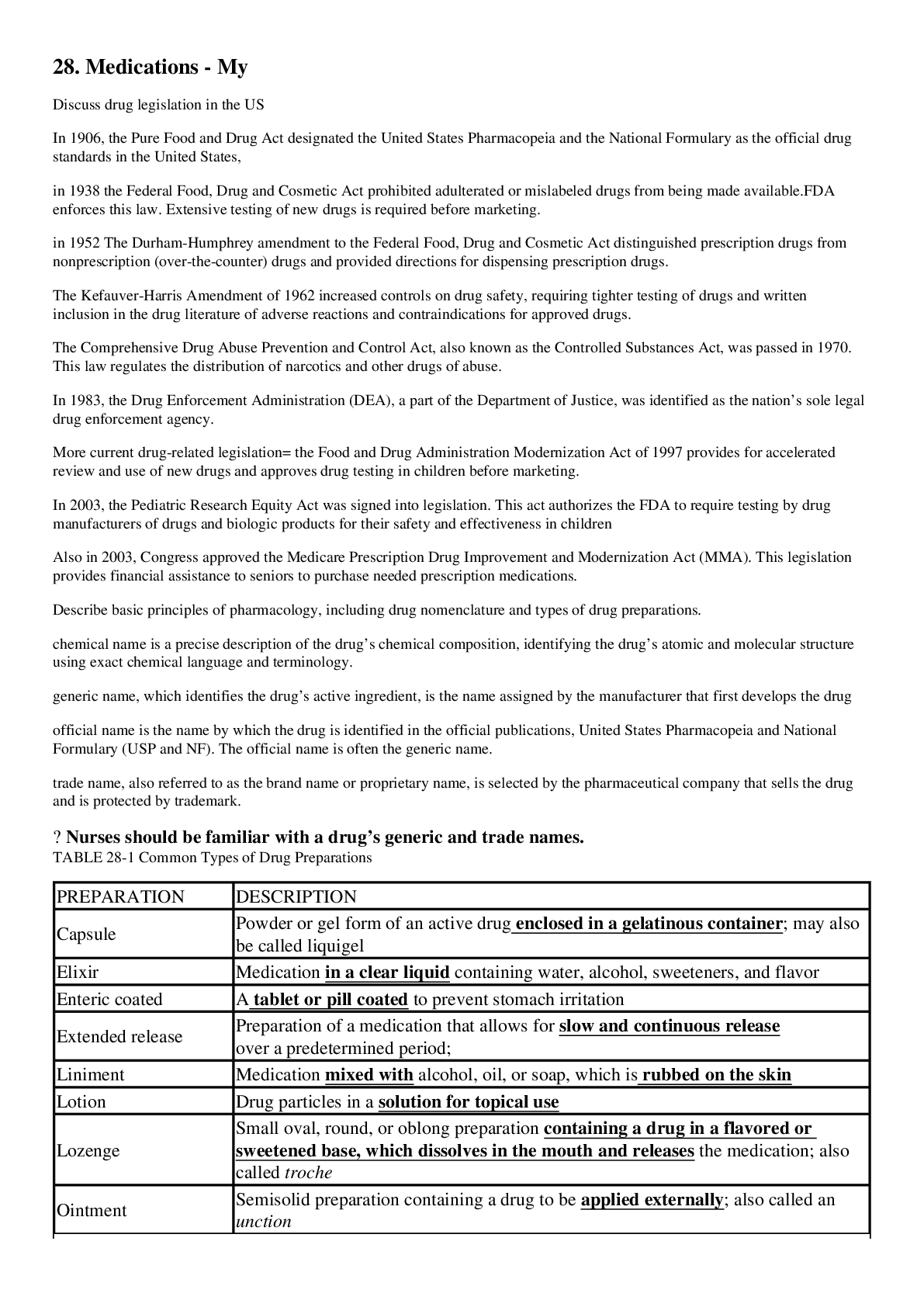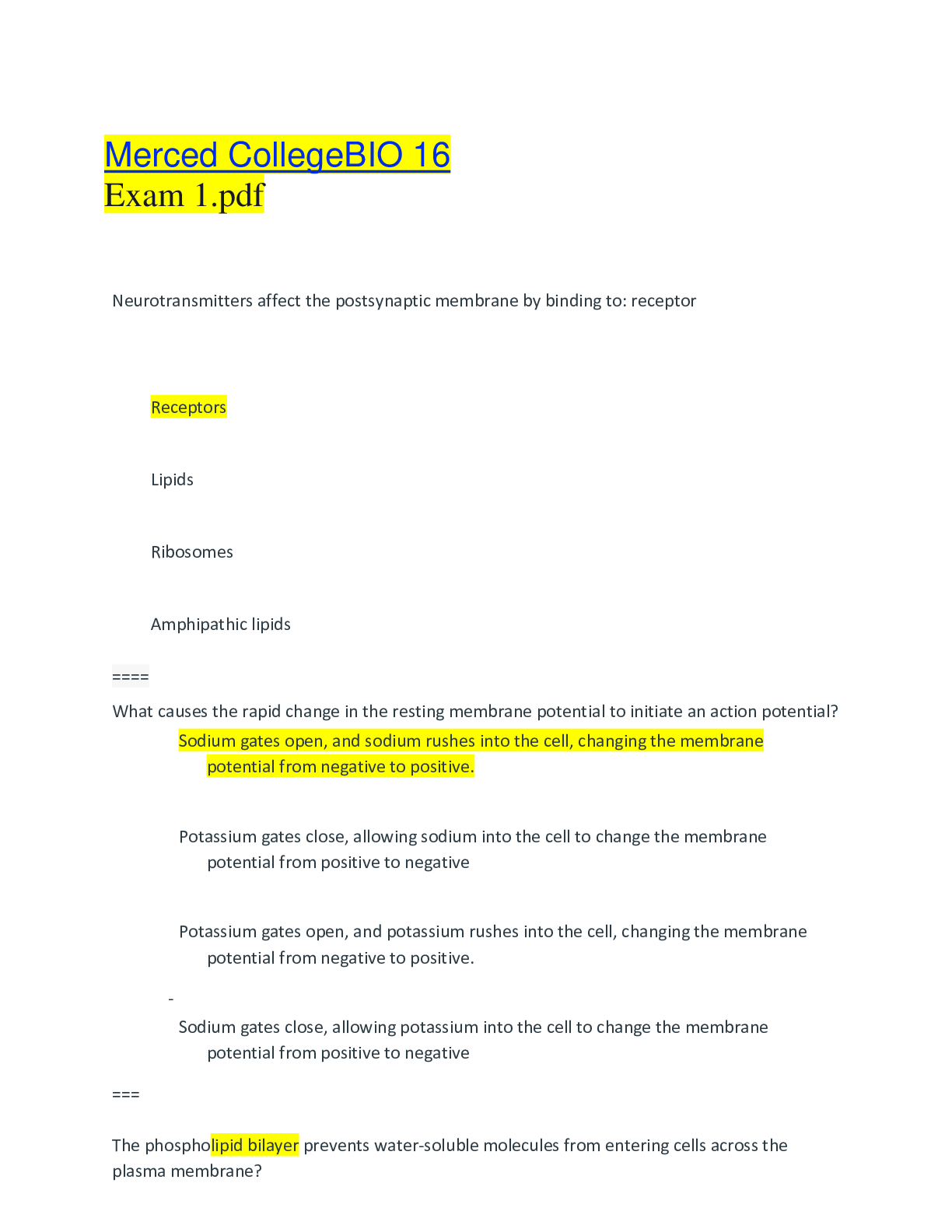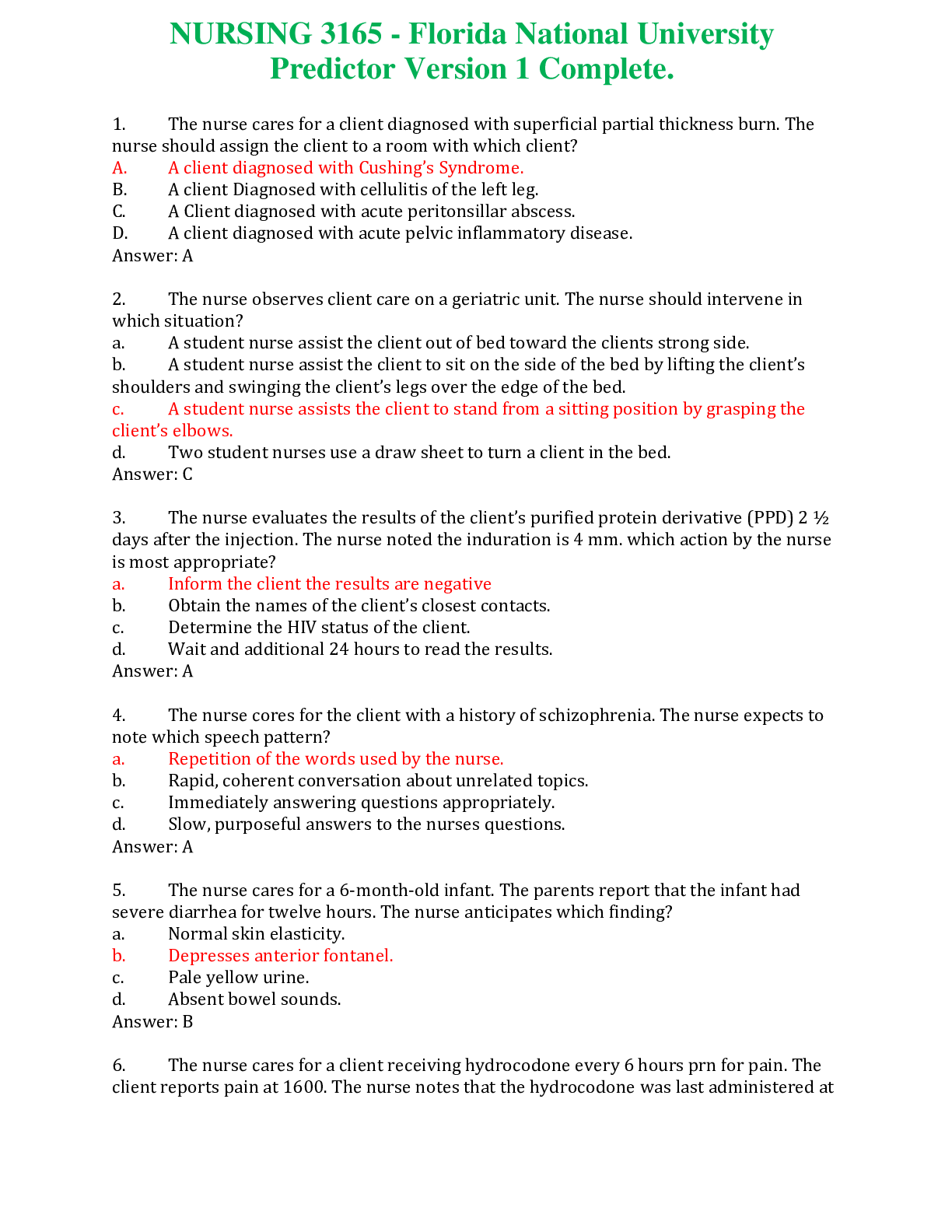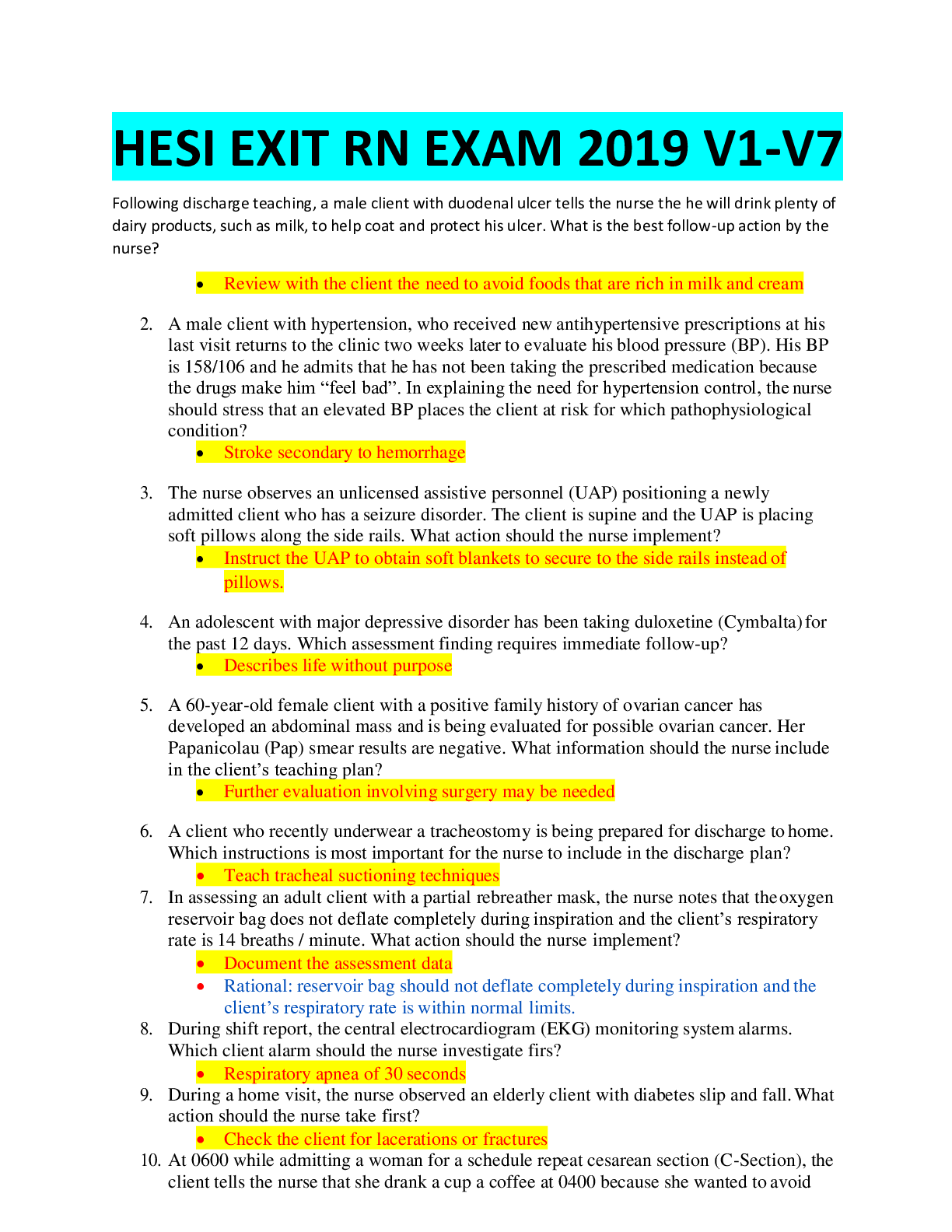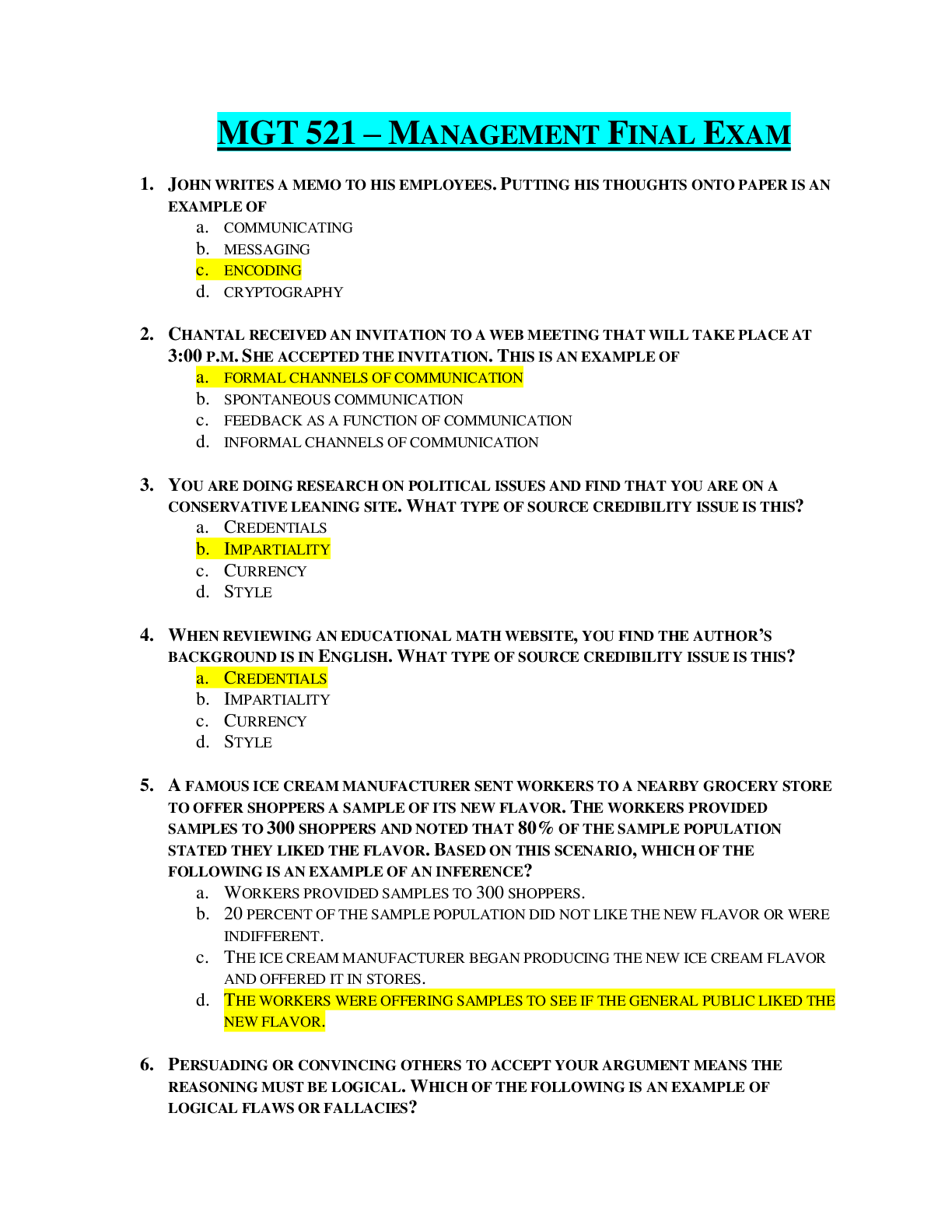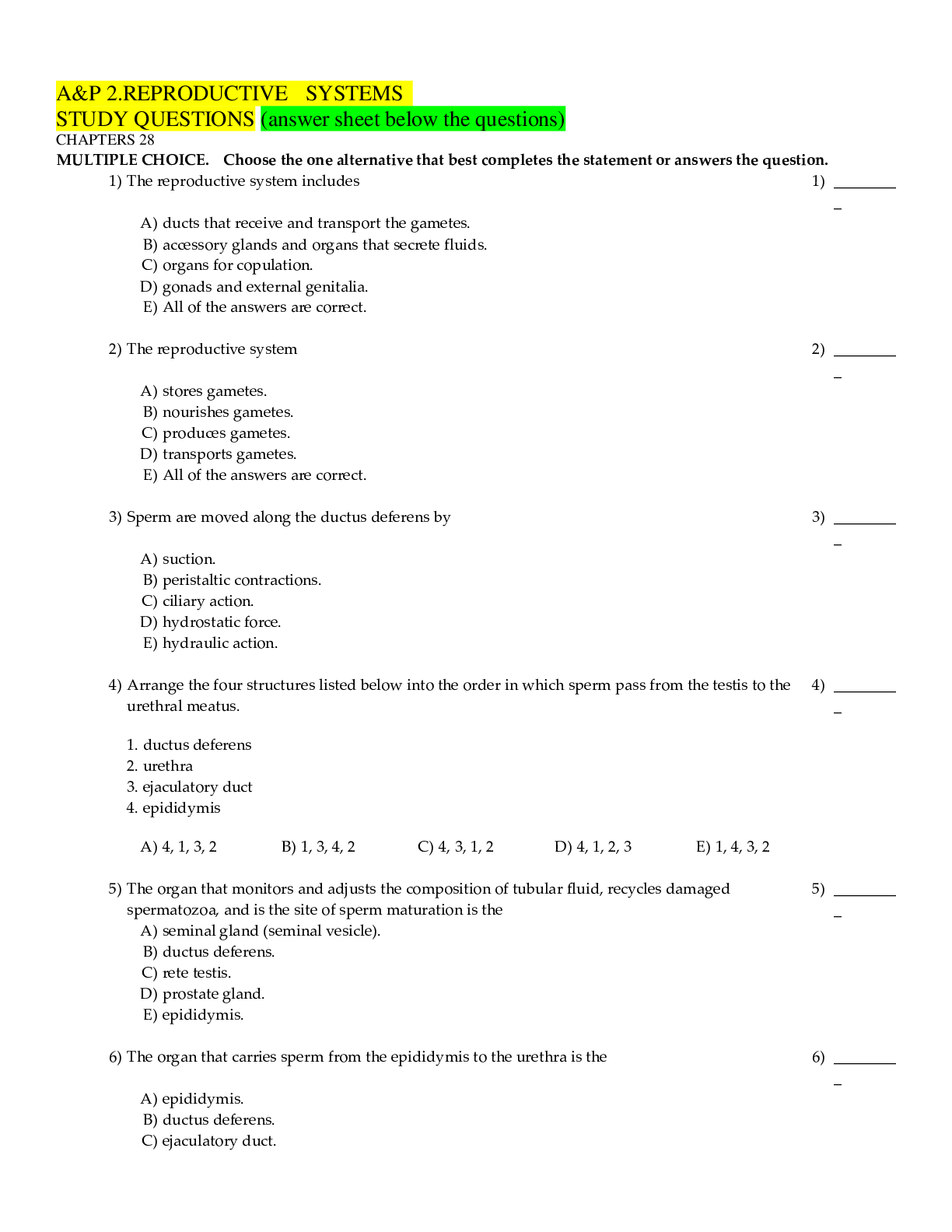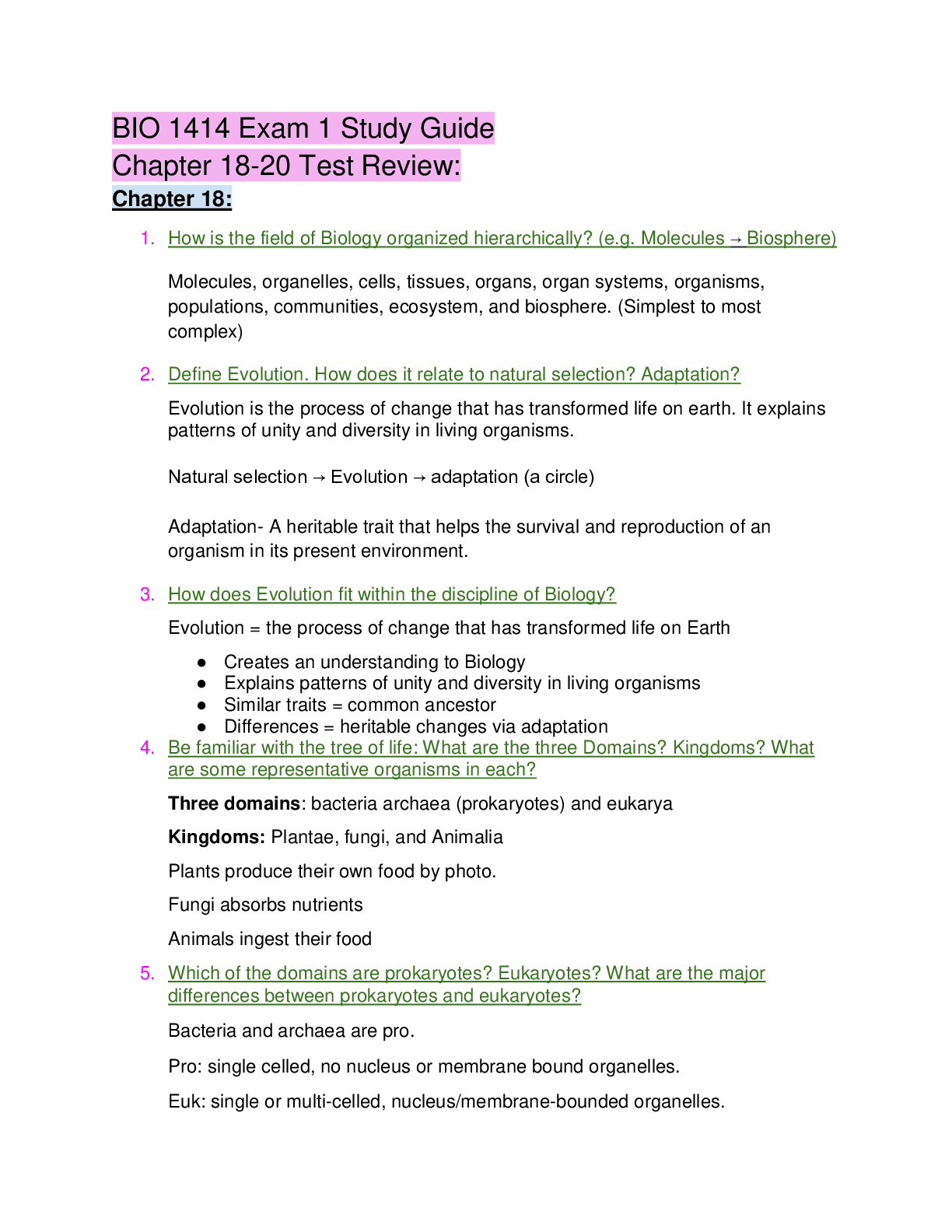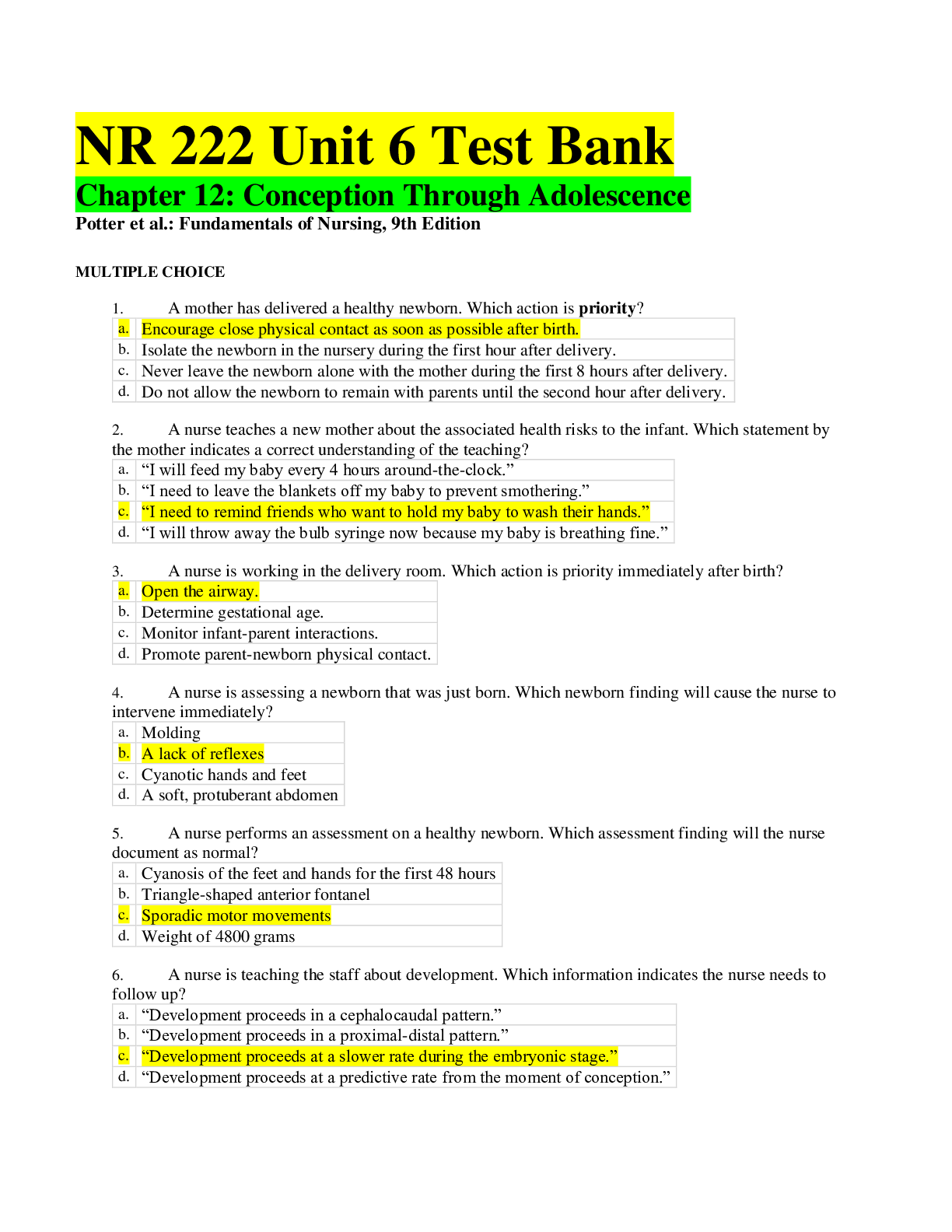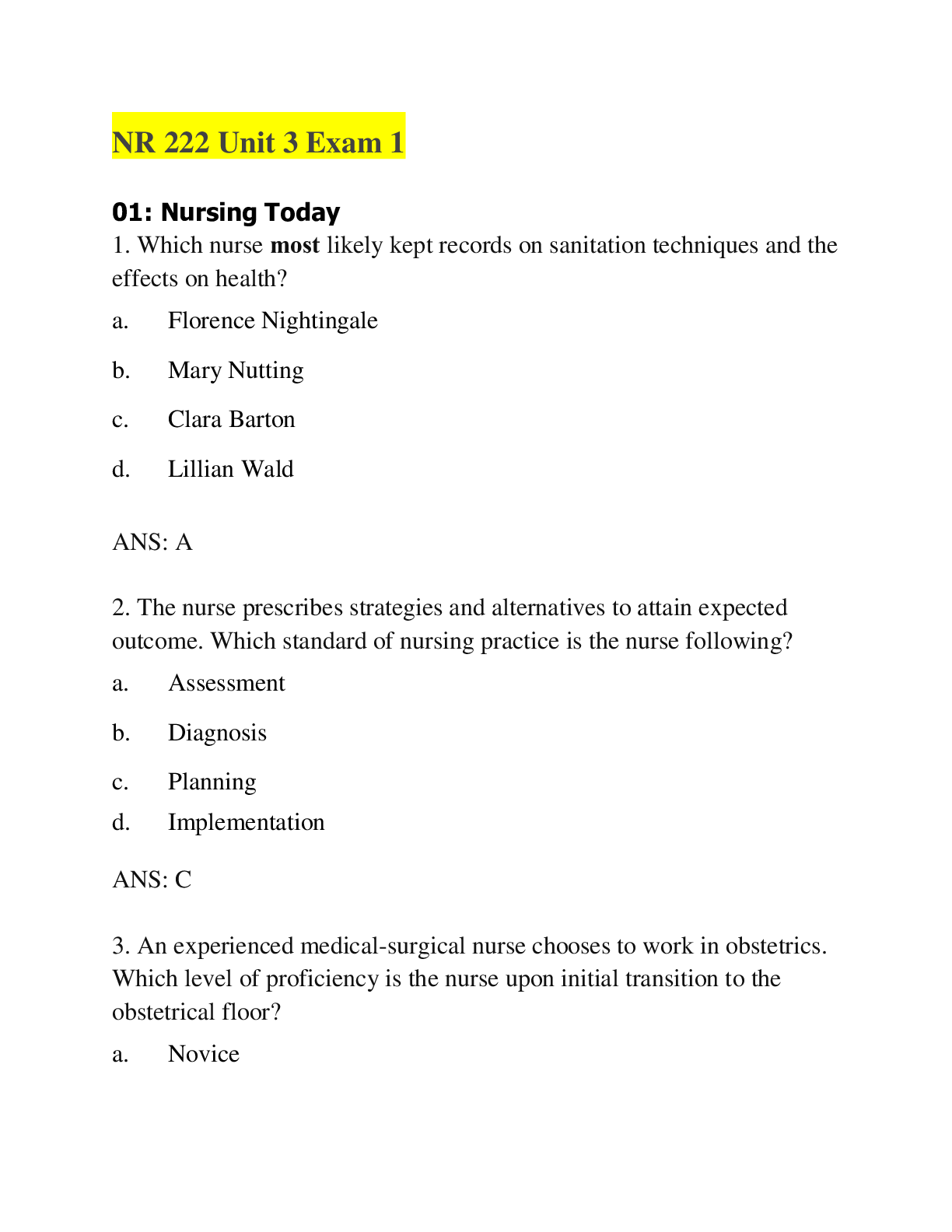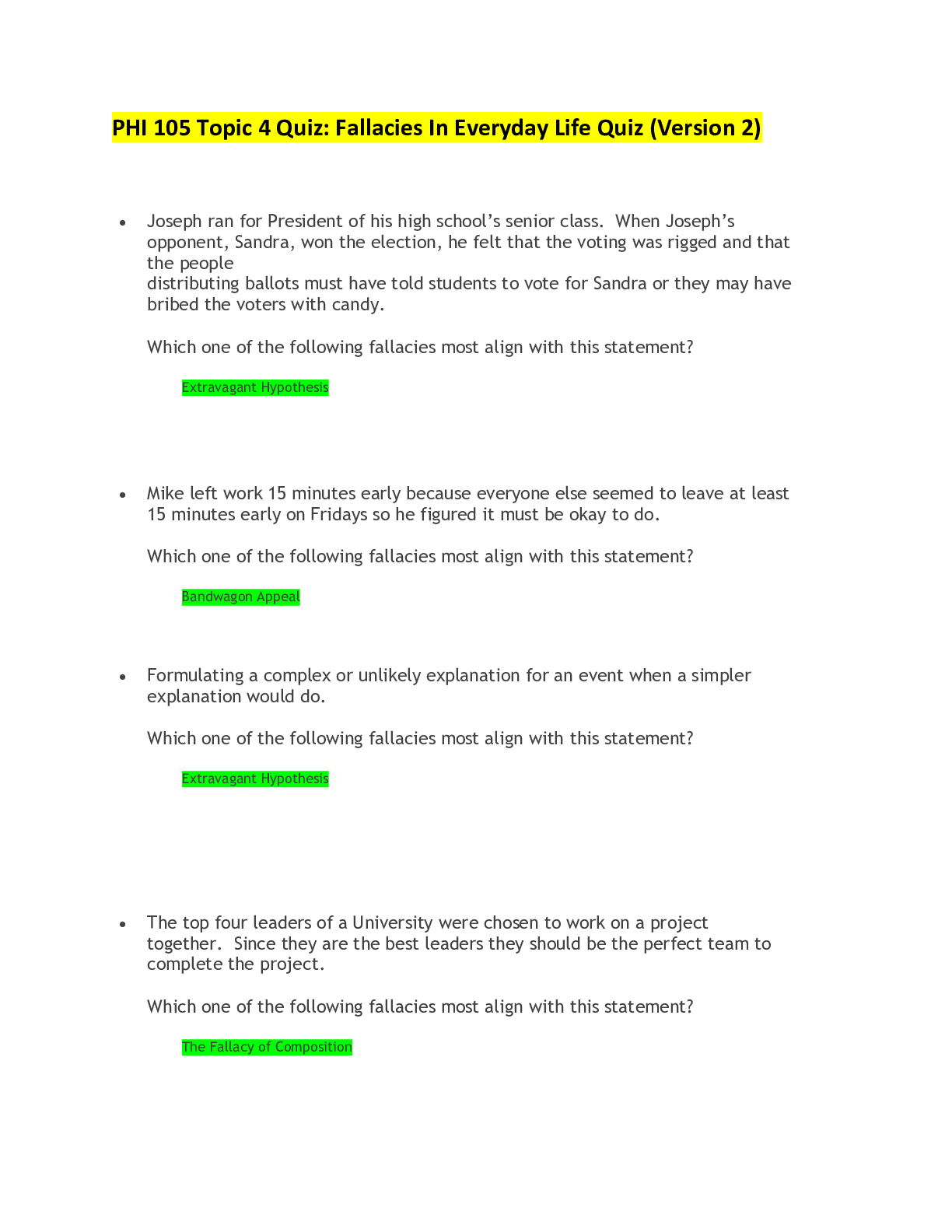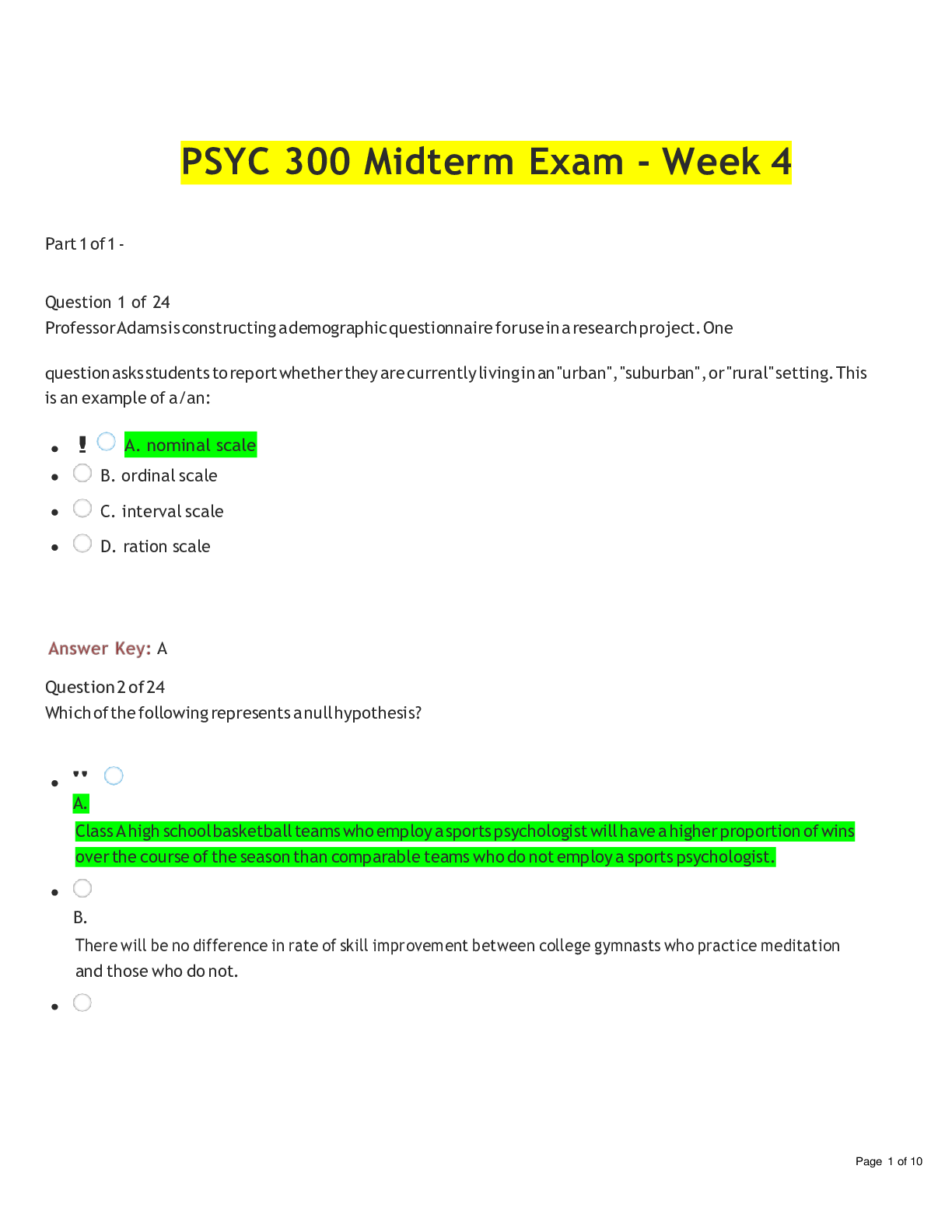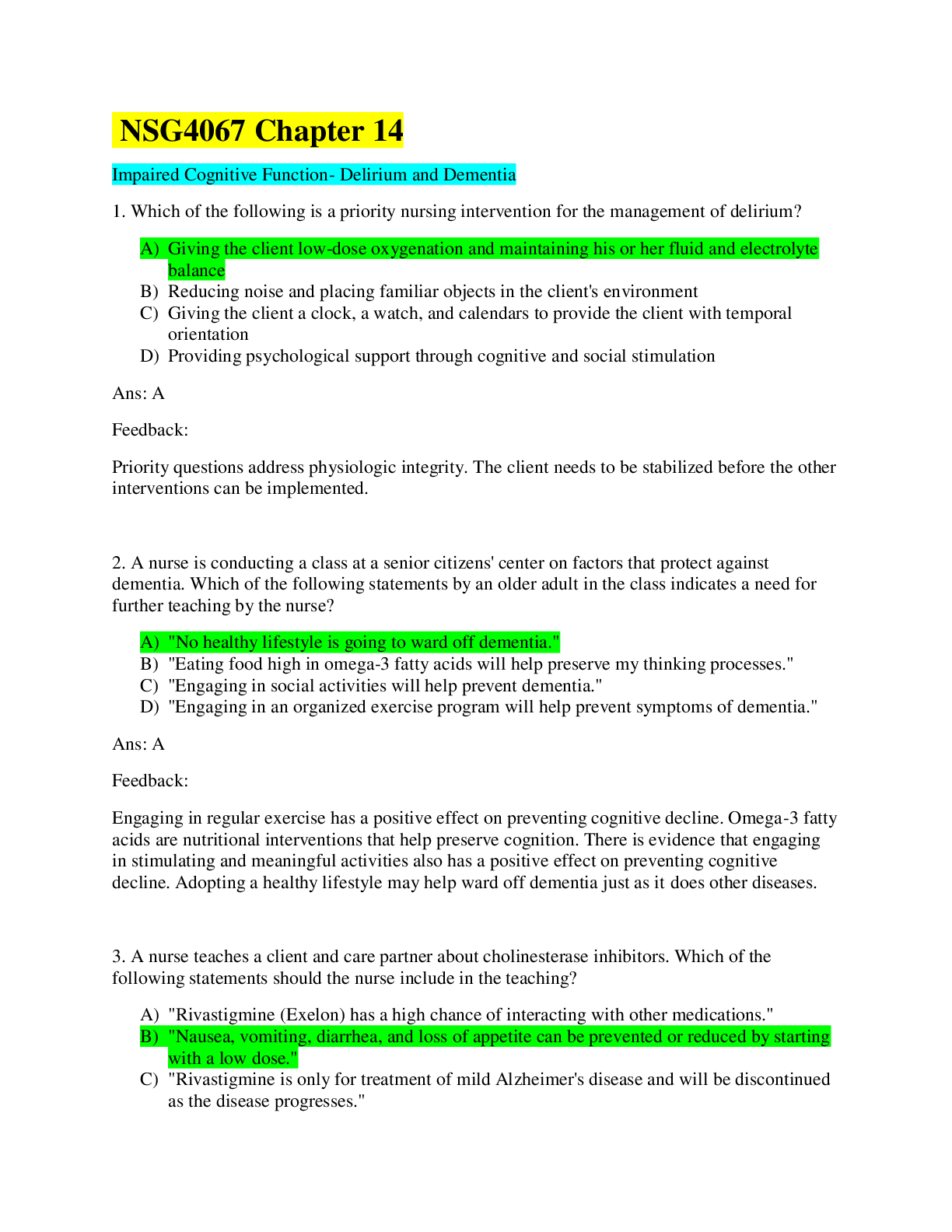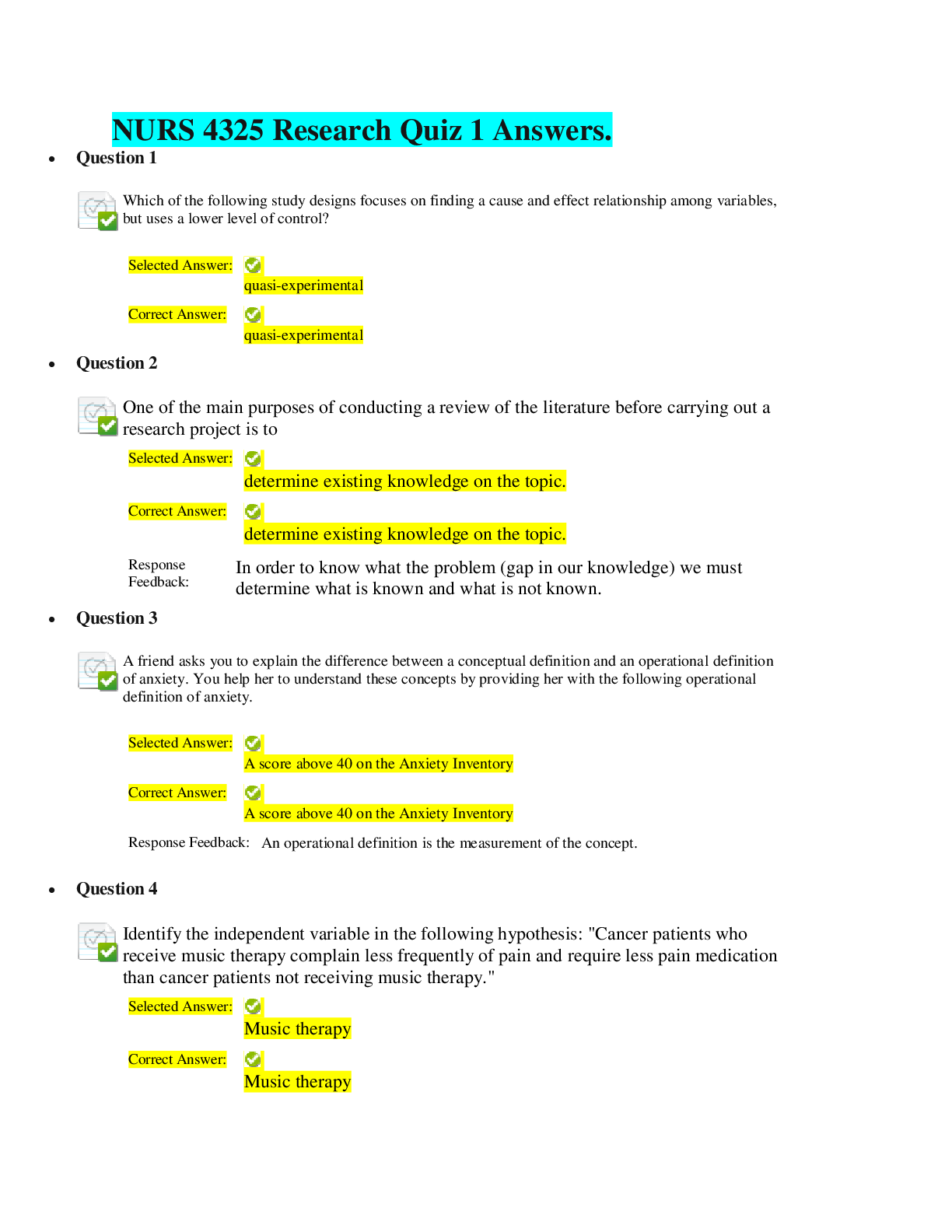*NURSING > QUESTIONS & ANSWERS > MH-Final Exam Questions & Answers (All)
MH-Final Exam Questions & Answers
Document Content and Description Below
6. A nursing student new to psychiatric-mental health nursing asks a peer what resources he can use to figure out which symptoms are present in a specific psychiatric disorder. The best answer would b... e: a. Nursing Interventions Classification (NIC) b. Nursing Outcomes Classification (NOC) c. NANDA-I nursing diagnoses d. DSM-5 7. Epidemiological studies contribute to improvements in care for individuals with mental disorders by: a. Providing information about effective nursing techniques. b. Identifying risk factors that contribute to the development of a disorder. c. Identifying individuals in the general population who will develop a specific disorder. d. Identifying which individuals will respond favorably to a specific treatment. 1. Besides antianxiety agents, which classification of drugs is also commonly given to treat anxiety and anxiety disorders? a. Antipsychotics b. Mood stabilizers c. Antidepressants d. Cholinesterase inhibitors 2. What assessment question will provide the nurse with information regarding the effects of a woman’s circadian rhythms on her quality of life? a. “How much sleep do you usually get each night?” b. “Does your heart ever seem to skip a beat?” c. “When was the last time you had a fever?” d. “Do you have problems urinating?” 3. You realize that your patient who is being treated for a major depressive disorder requires more teaching when she makes the following statement: a. “I have been on this antidepressant for 3 days. I realize that the full effect may not happen for a period of weeks.” b. “I am going to ask my nurse practitioner to discontinue my Prozac today and let me start taking a monoamine oxidase inhibitor tomorrow.” c. “I may ask to have my medication changed to Wellbutrin due to the problems I am having being romantic with my wife.” d. “I realize that there are many antidepressants and it might take a while until we find the one that works best for me.” 4. A patient being treated for insomnia is prescribed ramel-teon (Rozerem). Which comorbid mental health condition would make this medication the hypnotic of choice for this particular patient? a. Obsessive-compulsive disorder b. Generalized anxiety disorder c. Persistent depressive disorder d. Substance use disorder 5. Which statement made by a patient prescribed bupropion (Wellbutrin) demonstrates that the medication education the patient received was effective? Select all that apply. a. “I hope Wellbutrin will help my depression and also help me to finally quit smoking.” b. “I’m happy to hear that I won’t need to worry too much about weight gain.” c. “It’s okay to take Wellbutrin since I haven’t had a seizure in 6 months.” d. “I need to be careful about driving since the medication could make me drowsy.” e. “My partner and I have discussed the possible effects this medication could have on our sex life.” 6. Which drug group calls for nursing assessment for development of abnormal movement disorders among individuals who take therapeutic dosages? a. SSRIs b. antipsychotics c. benzodiazepines d. tricyclic antidepressants 9. The nurse administers each of the following drugs to various patients. The patient who should be most carefully assessed for fluid and electrolyte imbalance is the one receiving: a. lithium (Eskalith) b. clozapine (Clozaril) c. diazepam (Valium) d. amitriptyline 10. A psychiatric nurse is reviewing prescriptions for a patient with major depression at the county clinic. Since the patient has a mild intellectual disability, the nurse would question which classification of antidepressant drugs: a. Selective serotonin reuptake inhibitors b. Monoamine oxidase inhibitors c. Serotonin and norepinephrine reuptake inhibitors d. All of the above 4. The mental health team is determining treatment options for a male patient who is experiencing psychotic symptoms. Which question(s) should the team answer to determine whether a community outpatient or inpatient setting is most appropriate? Select all that apply. a. “Is the patient expressing suicidal thoughts?” b. “Does the patient have intact judgment and insight into his situation?” c. “Does the patient have experiences with either community or inpatient mental healthcare facilities?” d. “Does the patient require a therapeutic environment to support the management of psychotic symptoms?” e. “Does the patient require the regular involvement of their family/significant other in planning and executing the plan of care?” 10. Pablo is a homeless adult who has no family connection. Pablo passed out on the street and emergency medical services took him to the hospital where he expresses a wish to die. The physician recognizes evidence of substance use problems and mental health issues and recommends inpatient treatment for Pablo. What is the rationale for this treatment choice? Select all that apply. a. Intermittent supervision is available in inpatient settings. b. He requires stabilization of multiple symptoms. c. He has nutritional and self-care needs. d. Medication adherence will be mandated. e. He is in imminent danger of harming himself. 1. Which statement made by the nurse demonstrates the best understanding of nonverbal communication? a. “The patient’s verbal and nonverbal communication is often different.” b. “When my patient responds to my question, I check for congruence between verbal and nonverbal communication to help validate the response.” c. “If a patient is slumped in the chair, I can be sure he’s angry or depressed.” d. “It’s easier to understand verbal communication that nonverbal communication.” 2. Which nursing statement is an example of reflection? a. “I think this feeling will pass.” b. “So you are saying that life has no meaning.” c. “I’m not sure I understand what you mean.” d. “You look sad.” 3. When should a nurse be most alert to the possibility of communication errors resulting in harm to the patient? a. Change of shift report b. Admission interviews c. One-to-one conversations with patients d. Conversations with patient families 4. During an admission assessment and interview, which channels of information communication should the nurse be monitoring? Select all that apply. a. Auditory b. Visual c. Written d. Tactile e. Olfactory 5. What principle about nurse-patient communication should guide a nurse’s fear about “saying the wrong thing” to a patient? a. Patients tend to appreciate a well-meaning person who conveys genuine acceptance, respect, and concern for their situation. b. The patient is more interested in talking to you than listening to what you have to say and so is not likely to be offended. c. Considering the patient’s history, there is little chance that the comment will do any actual harm. d. Most people with a mentally illness have by necessity developed a high tolerance of forgiveness. 6. You have been working closely with a patient for the past month. Today he tells you he is looking forward to meeting with his new psychiatrist but frowns and avoids eye contact while reporting this to you. Which of the following responses would most likely be therapeutic? a. “A new psychiatrist is a chance to start fresh; I’m sure it will go well for you.” b. “You say you look forward to the meeting, but you appear anxious or unhappy.” c. “I notice that you frowned and avoided eye contact just now. Don’t you feel well?” d. “I get the impression you don’t really want to see your psychiatrist—can you tell me why?” 7. Which student behavior is consistent with therapeutic communication? a. Offering your opinion when asked to convey support. b. Summarizing the essence of the patient’s comments in your own words. c. Interrupting periods of silence before they become awkward for the patient. d. Telling the patient he did well when you approve of his statements or actions. 8. James is a 42-year-old patient with schizophrenia. He approaches you as you arrive for day shift and anxiously reports, “Last night, demons came to my room and tried to rape me.” Which response would be most therapeutic? a. “There are no such things as demons. What you saw were hallucinations.” b. “It is not possible for anyone to enter your room at night. You are safe here.” c. “You seem very upset. Please tell me more about what you experienced last night.” d. “That must have been very frightening, but we’ll check on you at night and you’ll be safe.” 9. Therapeutic communication is the foundation of a patient- centered interview. Which of the following techniques is not considered therapeutic? a. Restating b. Encouraging description of perception c. Summarizing d. Asking “why” questions 10. Carolina is surprised when her patient does not show for a regularly scheduled appointment. When contacted, the patient states, “I don’t need to come see you anymore. I have found a therapy app on my phone that I love.” How should Carolina respond to this news? a. “That sounds exciting, would you be willing to visit and show me the app?” b. “At this time, there is no real evidence that the app can replace our therapy.” c. “I am not sure that is a good idea right now, we are so close to progress.” d. “Why would you think that is a better option than meeting with me?” 1. Which statement demonstrates a well-structured attempt at limit setting? a. “Hitting me when you are angry is unacceptable.” b. “I expect you to behave yourself during dinner.” c. “Come here, right now!” d. “Good boys don’t bite.” 2. Which activity is most appropriate for a child with ADHD? a. Reading an adventure novel b. Monopoly c. Checkers d. Tennis 3. Cognitive-behavioral therapy is going well when a 12-year- old patient in therapy reports to the nurse practitioner: a. “I was so mad I wanted to hit my mother.” b. “I thought that everyone at school hated me. That’s not true. Most people like me and I have a friend named Todd.” c. “I forgot that you told me to breathe when I become angry.” d. “I scream as loud as I can when the train goes by the house.” 4. What assessment question should the nurse ask when attempting to determine a teenager’s mental health resilience? Select all that apply. a. “How did you cope when your father deployed with the Army for a year in Iraq?” b. “Who did you go to for advice while your father was away for a year in Iraq?” c. “How do you feel about talking to a mental health counselor?” d. “Where do you see yourself in 10 years?” e. “Do you like the school you go to?” 5. Which factors tend to increase the difficulty of diagnosing young children who demonstrate behaviors associated with mental illness? Select all that apply. a. Limited language skills b. Level of cognitive development c. Level of emotional development d. Parental denial that a problem exists e. Severity of the typical mental illnesses observed in young children 7. In pediatric mental health there is a lack of sufficient numbers of community-based resources and providers, and there are long waiting lists for services. This has resulted in: Select all that apply. a. Children of color and poor economic conditions being underserved b. Increased stress in the family unit c. Markedly increased funding d. Premature termination of services 8. Child protective services have removed 10-year-old Christopher from his parents’ home due to neglect. Christopher reveals to the nurse that he considers the woman next door his “nice” mom, that he loves school, and gets above average grades. The strongest explanation of this response is: a. Temperament b. Genetic factors c. Resilience d. Paradoxical effects of neglect 9. April, a 10-year-old admitted to inpatient pediatric care, has been getting more and more wound up and is losing self-control in the day room. Time-out does not appear to be an effective tool for April to engage in self-reflection. April’s mother admits to putting her in time-out up to 20 times a day. The nurse recognizes that: a. Time-out is an important part of April’s baseline discipline. b. Time-out is no longer an effective therapeutic measure. c. April enjoys time-out, and acts out to get some alone time. d. Time-out will need to be replaced with seclusion and restraint. 10. Adolescents often display fluctuations in mood along with undeveloped emotional regulation and poor tolerance for frustration. Emotional and behavioral control usually increases over the course of adolescence due to: a. Limited executive function b. Cerebellum maturation c. Cerebral stasis and hormonal changes d. A slight reduction in brain volume 1. Which characteristic in an adolescent female is sometimes associated with the prodromal phase of schizophrenia? a. Always afraid another student will steal her belongings. b. An unusual interest in numbers and specific topics. c. Demonstrates no interest in athletics or organized sports. d. Appears more comfortable among males. 2. Which nursing intervention is particularly well chosen for addressing a population at high risk for developing schizophrenia? a. Screening a group of males between the ages of 15 and 25 for early symptoms. b. Forming a support group for females aged 25 to 35 who are diagnosed with substance use issues. c. Providing a group for patients between the ages of 45 and 55 with information on coping skills that have proven to be effective. d. Educating the parents of a group of developmentally delayed 5- to 6-year-olds on the importance of early intervention. 3. To provide effective care for the patient diagnosed with schizophrenia, the nurse should frequently assess for which associated condition? Select all that apply. a. Alcohol use disorder b. Major depressive disorder c. Stomach cancer d. Polydipsia e. Metabolic syndrome 4. A female patient diagnosed with schizophrenia has been prescribed a first-generation antipsychotic medication. What information should the nurse provide to the patient regarding her signs and symptoms? a. Her memory problems will likely decrease. b. Depressive episodes should be less severe. c. She will probably enjoy social interactions more. d. She should experience a reduction in hallucinations. 5. Which characteristic presents the greatest risk for injury to others by the patient diagnosed with schizophrenia? a. Depersonalization b. Pressured speech c. Negative symptoms d. Paranoia 6. Gilbert, age 19, is described by his parents as a “moody child” with an onset of odd behavior about at age 14, which caused Gilbert to suffer academically and socially. Gilbert has lost the ability to complete household chores, is reluctant to leave the house, and is obsessed with the locks on the windows and doors. Due to Gilbert’s early and slow onset of what is now recognized as schizophrenia, his prognosis is considered: a. Favorable with medication b. In the relapse stage c. Improvable with psychosocial interventions d. To have a less positive outcome [Show More]
Last updated: 1 year ago
Preview 1 out of 72 pages
Instant download

Buy this document to get the full access instantly
Instant Download Access after purchase
Add to cartInstant download
Reviews( 0 )
Document information
Connected school, study & course
About the document
Uploaded On
Jan 26, 2021
Number of pages
72
Written in
Additional information
This document has been written for:
Uploaded
Jan 26, 2021
Downloads
0
Views
70

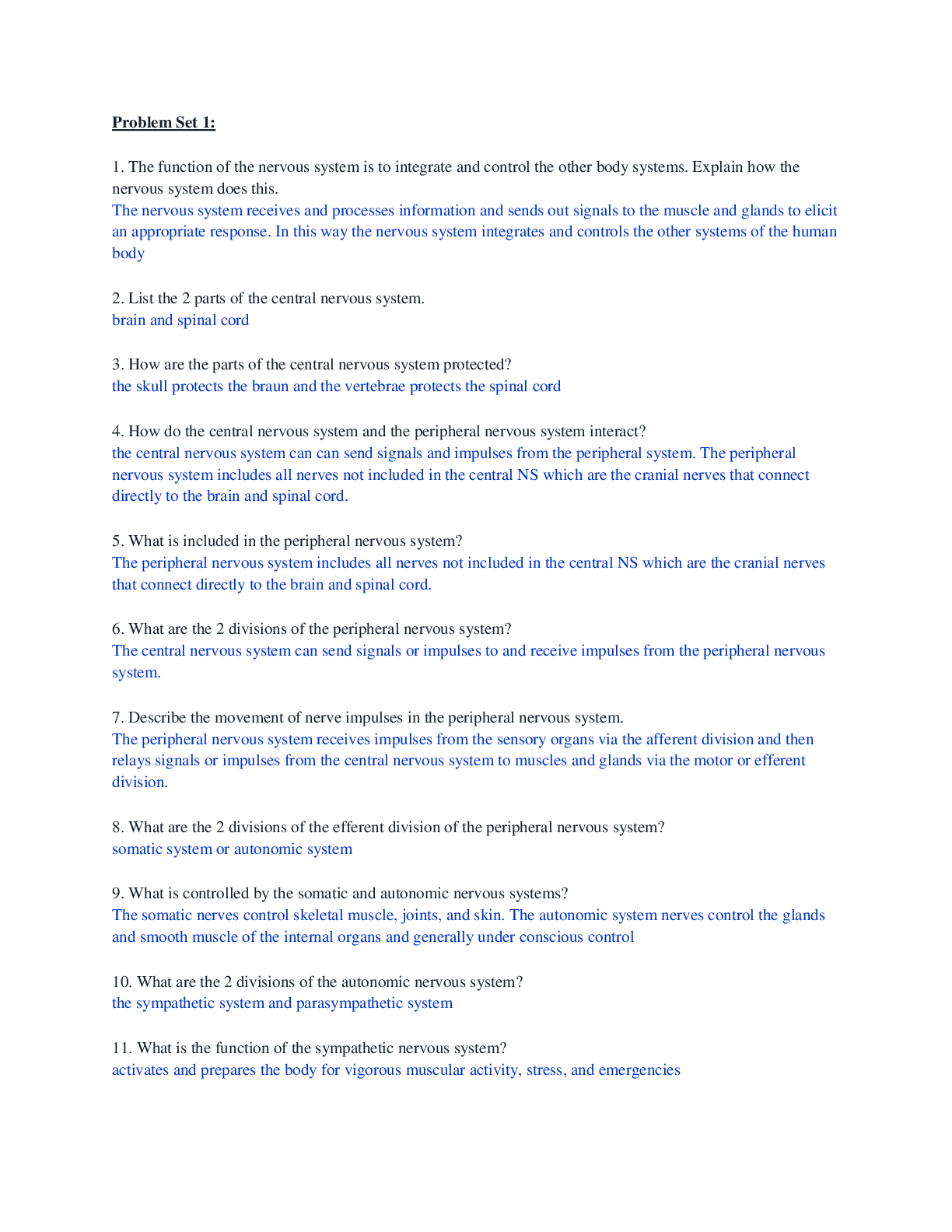
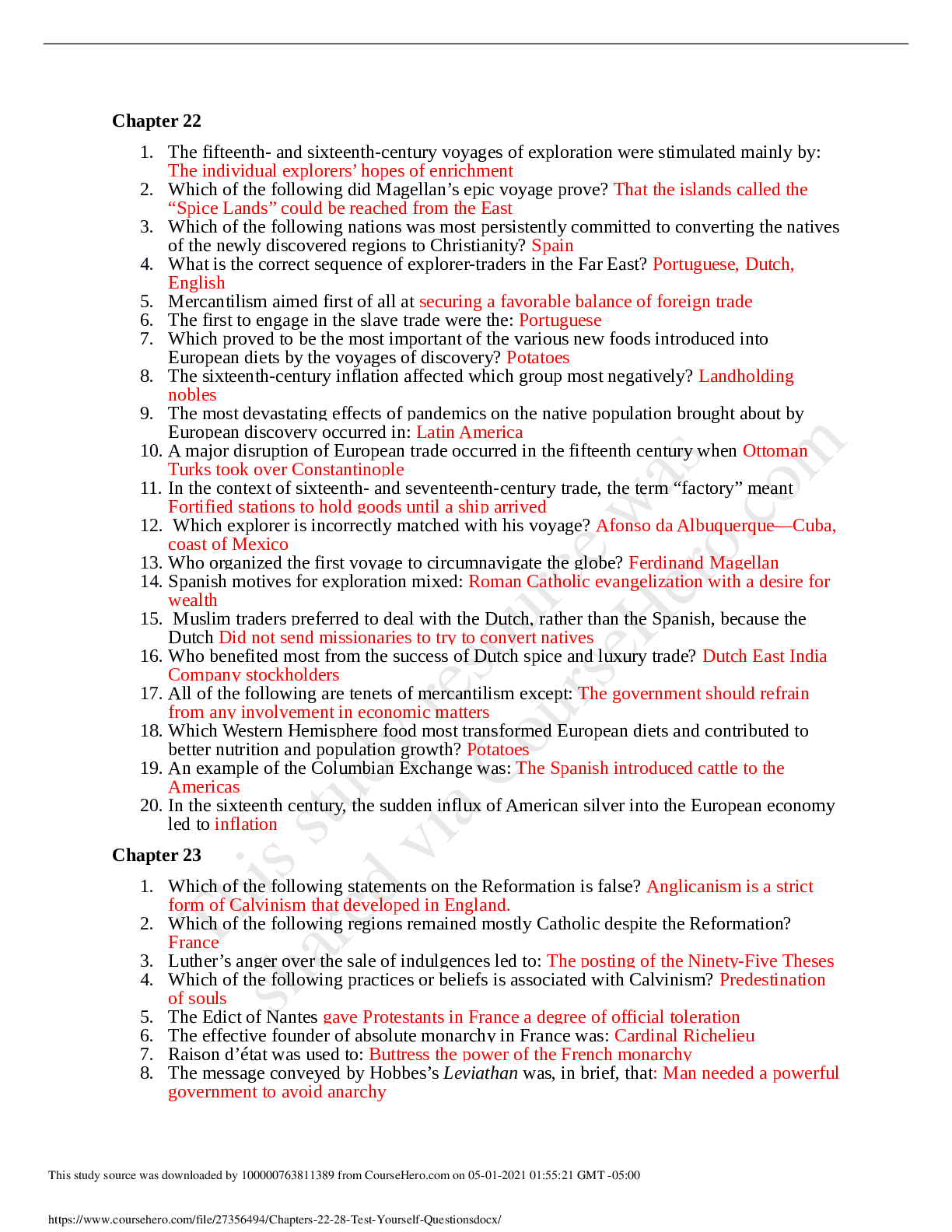

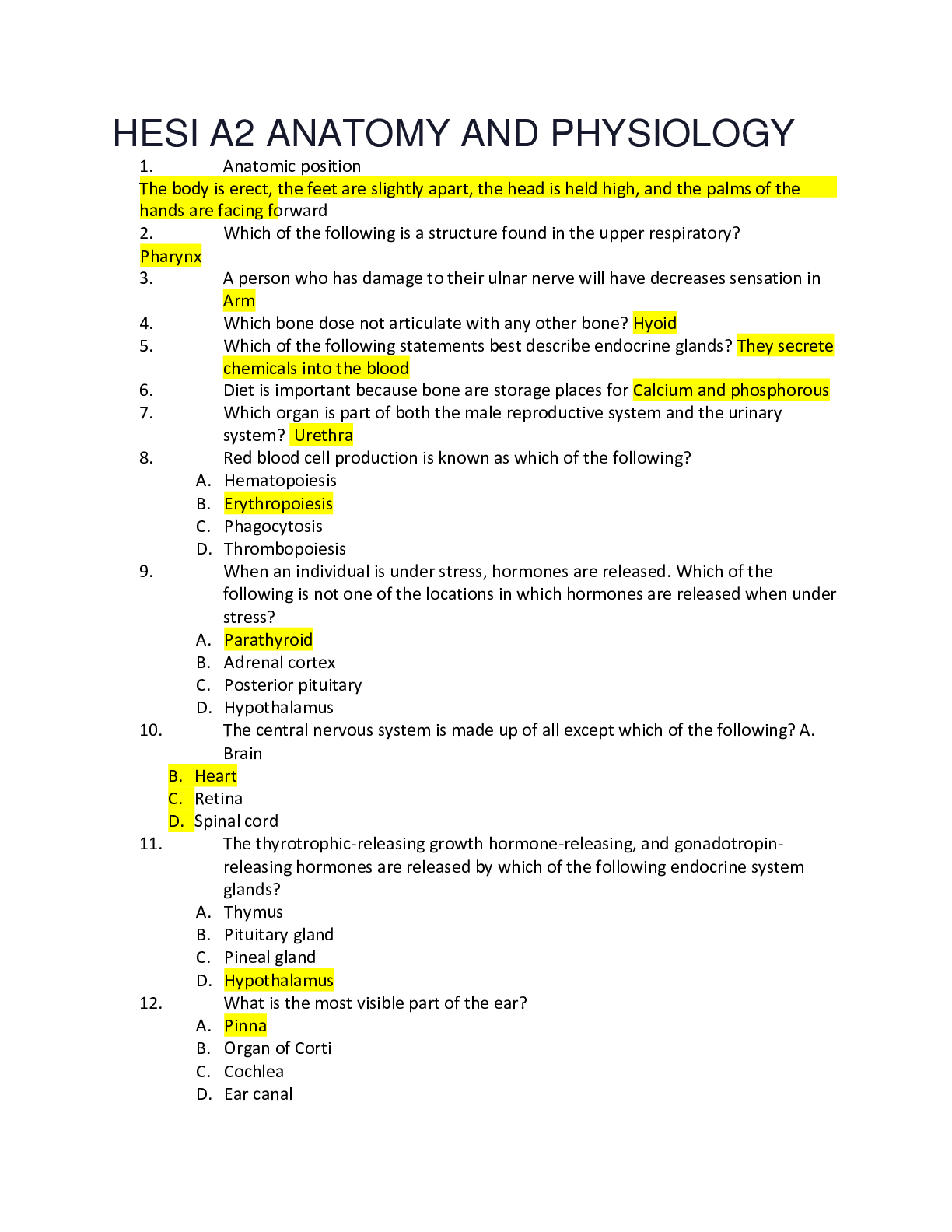
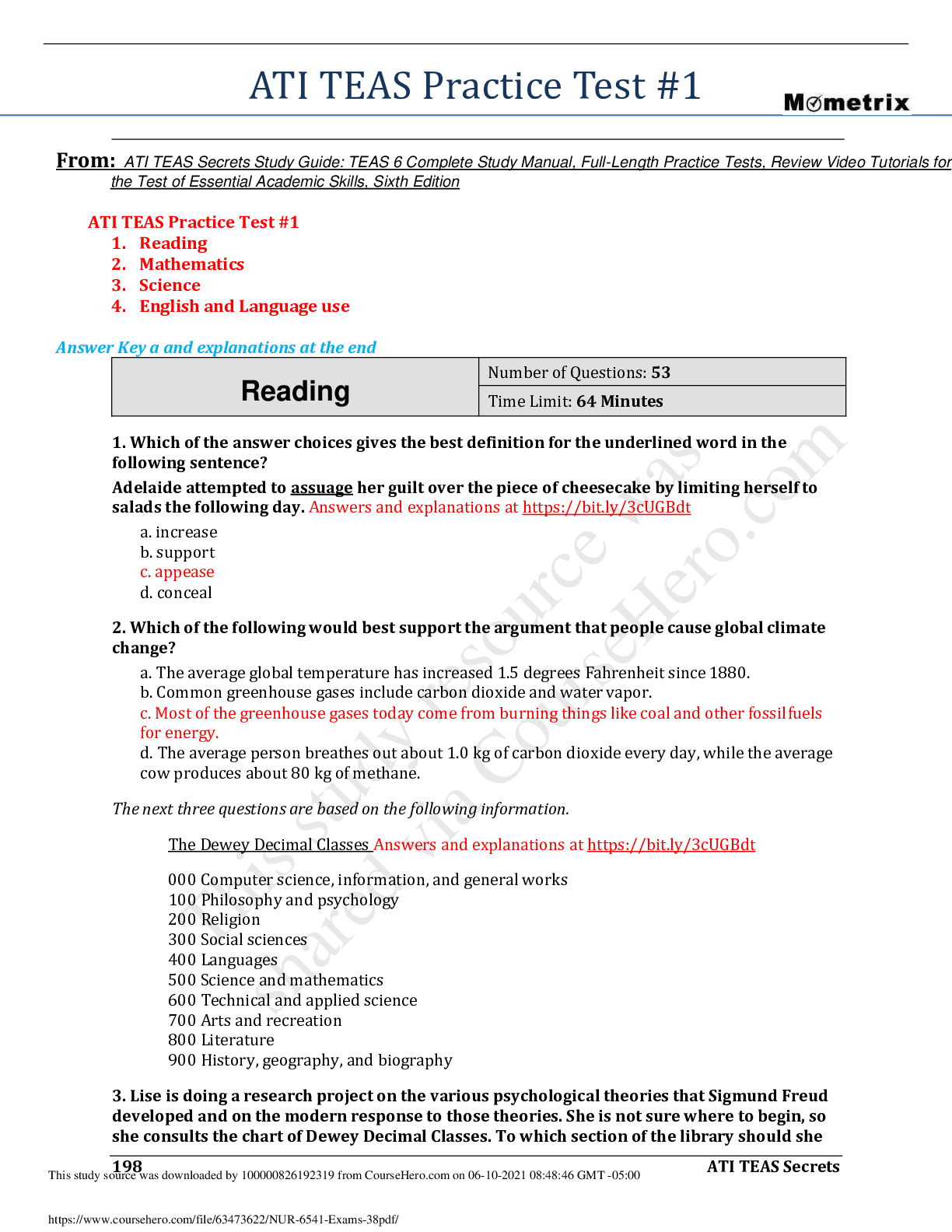
.png)

